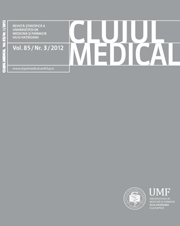Prevalence of Helicobacter Pylori Infection in Children with Gastritis and Peptic Ulcer Disease in North-western and Central Romania
Keywords:
Helicobacter pylori, gastritis, gastric ulcer, duodenal ulcerAbstract
Objectives. The objective of the survey was to assess the prevalence of Helicobacter pylori infection in children with gastritis, gastric ulcer and duodenal ulcer from the north-western and central part of Romania. At the same time, we investigated the correlation between the endoscopic appearance and the H. pylori infection, and the correlation between the inflammatory infiltrate and the degree of the H. pylori infection.
Methods. We conducted a retrospective analysis in 194 children (mean age 11.6 years) with nodular gastritis (n=102), non-nodular gastritis (n=58), gastric ulcer (n=20) and duodenal ulcer (n=14). The H. pylori presence was established based on the biopsy test and positive urease test. We compared the endoscopic appearance of the gastric mucosa and the histological aspect.
Results. The overall prevalence of H. pylori was 36.6%. Higher prevalence was found in children with duodenal ulcer (98.9%), followed by those with nodular gastritis (52.6%). The majority of the patients were female, except for those with gastric ulcer. The mean ages of the children with nodular gastritis, duodenal ulcer and children overall were significantly higher in the H. pylori positive group than in the H. pylori negative group (p<0.05). The density of intraepithelial neutrophils was significantly associated with the degree of H. pylori colonization (p<0.05). The lymphoid follicles were associated with the H. pylori infection (p<0.001).
Conclusions. The prevalence of H. pylori infection increases with age. The mean age of the children is higher in the H. pylori positive group than in the H. pylori negative group. Nodular gastritis is the most common type of H. pylori gastritis in childhood. H. pylori is the most important etiological factor in the development of duodenal ulcer in childhood. H. pylori infection does not appear to be a risk factor in gastric ulcer, other causes may be responsible for most cases. The degree of intraepithelial neutrophils could be an indicator for the degree of the H. pylori colonization.
Downloads
Published
How to Cite
Issue
Section
License
The authors are required to transfer the copyright of the published paper to the journal. This is done by agreeing to sign the Copyright Assignment Form. Whenever the case, authors are also required to send permissions to reproduce material (such as illustrations) from the copyright holder.

The papers published in the journal are licensed under a Creative Commons Attribution-NonCommercial-NoDerivatives 4.0 International License.

